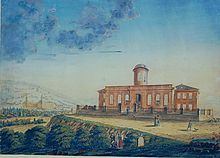First European Astronomers Congress
The first European astronomers' congress took place for about ten days until mid-August 1798 at the Seeberg observatory in Gotha .
prehistory
The Seeberg observatory, which was commissioned by Franz Xaver von Zach in 1790 , quickly became a focal point for the European astronomical community. Zach corresponded with almost all of his colleagues, and the observatory he designed was often visited because of its new type of facility.
In early 1798, the French astronomer Jérôme Lalande expressed the desire to get to know the Gotha observatory, where he hoped to meet the Berlin astronomer Johann Elert Bode . Zach also sent invitations to other astronomical experts for the meeting scheduled for early August ; this also included Derflinger, Barry, Rüdiger, David and Strnadt. Most of these invitations were received positively and supported by the respective sovereigns. Others, however, feared the influence of revolutionary French ideas. Jurij Vega from Vienna, invited by Lalande, was not allowed to travel to Gotha. Johann Hieronymus Schroeter in Lilienthal and Heinrich Wilhelm Olbers in Bremen stayed away because they suspected that the metric system of units was being propagated .
Attendees
- Johann Elert Bode (1747–1826), Berlin , astronomer
- George Butler (1774-1853), Cambridge , traveler, student
- Johannes Feer (1763–1823), Meiningen , surveyor
- Ludwig Wilhelm Gilbert (1769–1824), Halle , Prof. for physics
- Johann Kaspar Horner (1774–1834), Zurich , adjunct of Zach
- Johann Jakob Huber (1733–1798), Basel , astronomer
- Georg Simon Klügel (1739–1812), Halle , Prof. and optician
- Johann Gottfried Köhler (1745–1800), Dresden , Math.-Phys. salon
- Jérôme Lalande (1732–1807), Paris , astronomer
- Marie-Jeanne de Lalande (1768–1832), Paris , Astr. Calculator
- Carl Philipp Heinrich Pistor (1778–1847), Berlin , postal secretary and instrument maker
- Johann Konrad Schaubach (1764–1849), Meiningen , grammar school director
- Karl Felix von Seyffer (1762–1822), Göttingen , astronomer
- Johann Heinrich Seyffert (1751–1817), Dresden , finance secretary
- Johann Friedrich Wurm (1760–1833), Württemberg, Astr. Calculator, pastor
- Franz Xaver von Zach (1754–1832), Gotha , astronomer
Procedure and results
Jérôme Lalande arrived on the Seeberg on July 25th, together with his niece, the astronomical calculator Marie-Jeanne de Lalande. Most of the other participants followed between the beginning of August and August 9, the day of arrival from Bode. Wurm and Huber appeared after Bode.
Zach was able to accommodate most of the participants in his observatory buildings, but some also had to live in the “Zur Schelle” inn on Gotha's main market. On clear evenings, however, everyone was gathered for observations and discussions in the Seeberg observatory.
The scope of the discussions was broad. It was clear from the start that only closer cooperation could ensure the desired success. So the idea of an astronomical journal came about. Although the Berlin Astronomical Yearbook published by Johann Elert Bode already existed , it took too long to publish new research results in this series of publications, in which comparatively little space was given to descriptive texts.
The comparison of the instruments brought along, especially the chronometers and sextants , gave the mechanics present new ideas. Proposals for new constellations were not implemented, and the introduction of the metric system , an idea that emerged from the French Revolution , did not appear to be politically feasible in the individual countries. However, it was decided to use the metric system in their own work. Likewise, the meeting decided on Central European Time .
Practical exercises did not only take place at the observatory. Above all, the joint excursion to the Inselsberg on August 14, 1798 gave the opportunity to do so, especially since astronomical observations could be combined with barometric altitude measurements. The Duchess Charlotte von Sachsen-Gotha-Altenburg also took part in this work trip.
The social get-together was not neglected either. As the Duke's brother, Prince August , reported, the name day of Lalandes niece was celebrated with dances and a cannonade. Johann Jakob Huber , who had traveled from Basel, fell ill shortly after his arrival and died surprisingly on August 21; his son Daniel Huber , the mathematician and, like his father, an astronomer, arrived in Gotha on the occasion and made the acquaintance of Lalande and other scholars. The last participants left at the end of August 1798.
aftermath
A globe and a metric scale presented by Lalande are kept as souvenirs in the Museum of Regional History Gotha .
In 1998 the German Astronomical Society held its spring conference in Gotha on the occasion of the 200th anniversary of the first European Astronomical Congress. Over 120 astronomers from 15 countries met there. In honor of this anniversary, the asteroid (8130) Seeberg was named.
literature
- Dieter B. Herrmann : The Gotha astronomer meeting in 1798 - a forerunner of today's scientific congresses. In: Die Sterne , Volume 46 (1970), Issue 3, pp. 119-123.
- Manfred Strumpf. Gotha's astronomical epoch. Horb am Neckar: Geiger, 1998. ISBN 3-89570-381-8 .
Individual evidence
- ^ A b Kai Torsten Kanz: Nationalism and international cooperation in the natural sciences . The Franco-German Scientific Relations between Revolution and Restoration, 1789–1832. 1st edition. Franz Steiner Verlag, Stuttgart 1997, ISBN 978-3-515-07079-9 , pp. 212-213 ( online [accessed March 21, 2010]).
- ^ Emil A. Fellmann : Huber, Daniel. In: New German Biography (NDB). Volume 9, Duncker & Humblot, Berlin 1972, ISBN 3-428-00190-7 , p. 689 f. ( Digitized version ).
